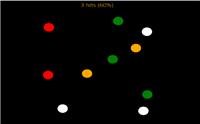Contents tagged with Attention
-
07 Jan 2013

We are very proud to announce that a psychological study, entirely made with EventIDE (and earlier program’s prototype) , has been published in one of the top research journal- Psychological Science. You can find the article, called “The Time Course of Perceptual Grouping in Natural Scenes” in the December 2012 issue or via this PubMed link .
-

MOT is a famous experimental paradigm used to study how our visual system tracks multiple moving objects. The paradigm was developed by Pylyshyn and Storm in 1988 and subsequently adapted in numerous studies. The common finding over these studies is that there is a limited number of moving objects that the visual system can track in a parallel.
There are two prominent theories explaining a limited capacity in the MOT task: the earliest FINST theory (Pylyshyn 1989, 1994) postulating that brain has a limited (around 4) of tracking 'pointers' that can be attached to moving objects (Pylyshin et al). Another theory, proposed and tested by Yantis in 1992 , suggests that all tracking objects are grouped into one higher order group with each object making a vertex in a virtual polygon.
We developed two EventIDE templates of the MOT task, with two types of participant's response taken after end of a motion. The first template replicates the original Pylyshyn 's paradigm, where a Yes-No response indicates whether a single probed object belongs to a subset of tracking objects. The second template allows participant to indicate all tracking objects with a mouse. The later response type became a standard in the MOT recent studies.
The template contain a code that generates unpredictable trajectories for occlusion-free motion of multiple objects. Trajectory generation is a random process controlled by several initial parameters that can be customized. In addition, the templates demonstrate how to use recurrent events to create a time-precise animation with EventIDE.
Submitted by on 16 Dec 2012
-

This study measures a time-course of perceptual processes when a task requires grouping image segments that belong to the same object in natural scenes. Contrary to a widely held view that perceptual grouping occurs in parallel across the visual scene and without attention, the results imply that perception starts with rapid object classification and that rapid classification is followed by a serial perceptual grouping phase, which is more efficient for objects in a familiar orientation than for objects in an unfamiliar orientation.
Submitted by on 01 Dec 2012
